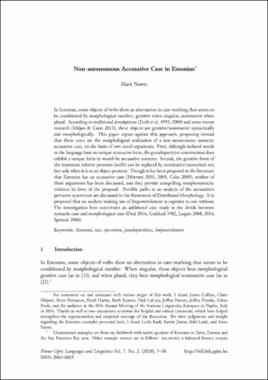| dc.contributor.author | Norris, Mark | |
| dc.date.accessioned | 2019-06-24T14:30:54Z | |
| dc.date.available | 2019-06-24T14:30:54Z | |
| dc.date.issued | 2018 | |
| dc.identifier.citation | Norris, Mark. 2019. Non-autonomous accusative case in Estonian. Finno-Ugric Languages and Linguistics 7(2), 7–38. | en_US |
| dc.identifier.uri | https://hdl.handle.net/11244/320359 | |
| dc.description | This article appeared in a special issue of Finno-Ugric Languages and Linguistics that was dedicated to Estonian. The article did not appear online until 2019, but the journal listed the publication date as 2018. I contacted the journal to clarify, but they haven't responded yet. For this submission, I went with 2018. | en_US |
| dc.description.abstract | In Estonian, some objects of verbs show an alternation in case-marking that seems to be conditioned by morphological number: genitive when singular, nominative when plural. According to traditional descriptions (Erelt et al. 1993, 2000) and some recent research (Miljan & Cann 2013), these objects are genitive/nominative syntactically and morphologically. This paper argues against this approach, proposing instead that these cases are the morphological realization of a non-autonomous syntactic accusative case, on the basis of two novel arguments. First, although isolated words in the language have no unique accusative form, the pseudopartitive construction does exhibit a unique form in would-be accusative contexts. Second, the genitive form of the inanimate relative pronoun (mille) can be replaced by nominative/unmarked mis, but only when it is in an object position. Though it has been proposed in the literature that Estonian has an accusative case (Hiietam 2003, 2005, Caha 2009), neither of these arguments has been discussed, and they provide compelling morphosyntactic evidence in favor of the proposal. Possible paths to an analysis of the accusative’s pervasive syncretism are discussed in the framework of Distributed Morphology. It is proposed that an analysis making use of Impoverishment is superior to one without. The investigation here constitutes an additional case study in the divide between syntactic case and morphological case (Deal 2016, Goddard 1982, Legate 2008, 2014, Spencer 2006). | en_US |
| dc.language | en_US | en_US |
| dc.rights | Attribution-NonCommercial-ShareAlike 4.0 International | * |
| dc.rights.uri | https://creativecommons.org/licenses/by-nc-sa/4.0/ | * |
| dc.subject | Language, Linguistics. | en_US |
| dc.subject | Syntax | en_US |
| dc.subject | Morphology | en_US |
| dc.subject | Theoretical linguistics | en_US |
| dc.subject | Generative grammar | en_US |
| dc.subject | Case | en_US |
| dc.subject | Language, Finno-Ugric | en_US |
| dc.subject | Estonian | en_US |
| dc.title | Non-autonomous accusative case in Estonian | en_US |
| dc.type | Article | en_US |
| dc.description.peerreview | Yes | en_US |
| dc.description.peerreviewnotes | Double-blind peer review by two reviewers. Accepted with revisions on the first pass | en_US |
| dc.identifier.doi | 10.15763/11244/320359 | en_US |
| ou.group | College of Arts and Sciences::Department of Modern Languages, Literatures, and Linguistics | en_US |

